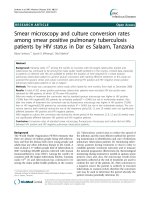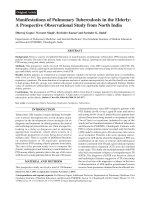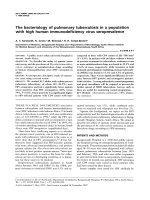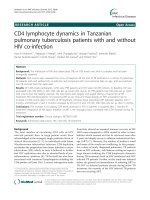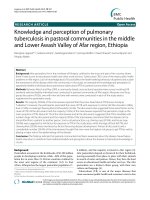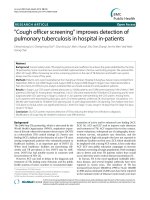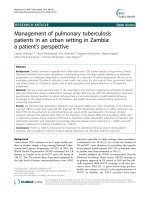Management of pulmonary tuberculosis patients in an urban setting in Zambia: a patient’s perspective ppt
Bạn đang xem bản rút gọn của tài liệu. Xem và tải ngay bản đầy đủ của tài liệu tại đây (221.29 KB, 8 trang )
RESEARC H ARTIC LE Open Access
Management of pulmonary tuberculosis
patients in an urban setting in Zambia:
a patient’s perspective
Chanda Mulenga
1,2*
, David Mwakazanga
1
, Kim Vereecken
3
, Shepherd Khondowe
1
, Nathan Kapata
4
,
Isdore Chola Shamputa
1,5
, Herman Meulemans
6
, Leen Rigouts
2,7
Abstract
Background: Zambia continues to grapple with a high tuberculosis (TB) burden despite a long running Directly
Observed Treatment Short course programme. Understanding issues that affect patient adherence to treatment
programme is an important component in implementation of a successful TB control programme. We set out to
investigate pulmonary TB patient’ s attitudes to seek health care, assess the care received from government health
care centres based on TB patients’ reports, and to seek associations with patient adherence to TB treatment
programme.
Methods: This was a cross-sectional study of 105 respondents who had been registered as pulmonary TB patients
(new and retreatment cases) in Ndola District between January 2006 and July 2007. We administered a structured
questionnaire, bearing questions to obtain individual data on socio-demographics, health seeking behaviour,
knowledge on TB, reported adherence to TB treatment, and health centre care received during treatment to
consenting respondents.
Results: We identified that respondents delayed to seek treatment (68%) even when knowledge of TB symptoms
was high (78%) or when they suspected that they had TB (73%). Respondent adherence to taking me dication was
high (77%) but low adherence to submitting follow-up sputum (47%) was observed in this group. Similarly,
caregivers educate their patients more often on the treatment of the disease (98%) and drug taking (100%), than
on submitting sputum during treatment (53%) and its importance (54%). Respondent adherence to treatment was
significantly associated with respondent’s knowledge about the disease and its treatment (p < 0.0001), and with
caregiver’s adherence to treatment guidelines (p = 0.0027).
Conclusions: There is a need to emphasise the importance of submitting follow-u p sputum during patient
education and counselling in order to enhance patient adherence and ultimately treatment outcome.
Background
Tuberculosis (TB) continues to be a major health pro-
blem in Zambia, despite a long running National Tuber-
culosis and Leprosy Programme (NTLP). In 2007, the
World Health Organization (WHO) estimated the TB
burden in Zambia to be at 60,337 cases (all forms of
TB) [1]. The TB control efforts have been hampered by
the high level of human immunodeficiency virus (HIV)
infection, especially in urban settings where prevalence
is estimated to be 19.7% [2]. As a result the number of
TB a nd HIV cases threatens to overwhelm the capacity
of the general health systems. HIV-TB co-infection rates
in Zambia have been estimated at 70% [1].
Zambia adopted the WHO recommended Directly
Observed Treatment S hort course (DOTS) strategy as
its primary approach in TB control in 1993 and has offi-
cially reported 100% DOTS coverage in all nine pro-
vinces since 2003 [3]. A good functioning primary
health care system is crucial in the implementation of
DOTS. In Zambia, the NTLP activities have been
* Correspondence:
1
Tropical Diseases Research Centre, Biomedical Sciences Department, P. O.
Box 71769, Ndola, Zambia
Full list of author information is available at the end of the article
Mulenga et al. BMC Public Health 2010, 10:756
/>© 2010 Mulenga et al; licensee BioMed Central Ltd. This is an Open Access article distributed under the terms of the Creative
Commons Attribution License (<url>http://c reativecommons.org/licenses/by/2.0</url>), which permits unrestricted use, distribution,
and reprodu ction in any medium, provided the original work is properly cited.
integrated into the primary health care services. The
decentralisation of TB treatment services has provided
for m ore responsibility at the lower levels o f the health
care system and in the face of an overwhelming TB
case-load, t his move has proved to be beneficial to the
practical implementation of the programme. Despite the
human resource challenges, the use of treatment sup-
porters and community volunteers in the implementa-
tion of DOTS has contributed to the improvement in
cure rates over the past decade from 67% in 2000 to the
global target of 85% by 2006 [3]. The goal of the Zam-
bian NTLP is to prevent and control T B through the
provision of q uality diagnostic and treatment services
for TB and TB/HIV- infected individ uals at all levels of
the health care delivery system [4].
Asse ssing access to quality of healthcare servi ce deliv-
ery is complex and multidimensional and will depend
on several aspects that are both patient/community-
related and/or health systems/service related. Several
questions could be considered in this vein, for example,
are patients seeking help when they are sick, and when
they do seek healthcare, are they getting the appropriate
care they require when they need it and ultimately, is
this care effective when they get it? Understanding the
factors that affect or influence care actions in different
settings, will ultimately result in an improvement in
healthcare delivery.
Although there are several reports about health
seeking behaviour of TB patients and factors related to
their delay in seeking health care, compliance to treat-
ment and the role of these factors in treatment out-
come, only a few studies describe patient experience
in accessing TB care throughout treatment. This study
describes and assesses the care received by pulmo nary
TB patients fr om government healt h care centres, and
the association with patien t adherence to TB treat-
ment based on previous TB patients’ reports. The
study also alludes to patient’s attitude to seek health
care for TB.
Methods
Study design and population
This was a cross-sectional study of subjects who had
been treated for pulmonary TB through the NTLP at
government health centres in Ndola, an urbanized city
ontheCopperbeltProvinceofZambiawithanesti-
mated population of 374,757 persons [5], representative
of many urban towns along the line of rail in Zambia.
At the time of the study, the Ndola District Health
Management Team (NDHMT) provided health care ser-
vices through 26 health centres. All the health ce ntres
provided TB treatment and care (treatment centres), but
only six w ere able t o perform Acid Fast Bacilli (AFB)
smear microscopy (diagnostic centres).
Sampling and sample size
The sampling frame comprised the names of all the
smear-positive TB patients, new and retreatment cases,
registered in the TB microscopy laboratory registers at
the six diagnostic centres between January 2006 and
July 2007, as a record of all smear-positive patients
undergoing treatment in the 2 6 treatment centres in
that period. Those that had received treatment from pri-
vate clinics or hospitals and children less than 18 years
of age were not included. A sample of 105 respondents
was randomly selected from the sampling frame. The
sample size was calculated using Epi Info 3.5.1 (Centers
for Disease Control and Prevention, Atlanta, GA, USA).
Based on pre-test results, we expected a frequency of
patient compliance and adherence to treatment of 50%
±10%, at a confidence interval of 95%, and non-response
level of 10%, and therefore estimated a sample size of
105 as sufficient.
Data collection, management and analysis
Initial contact with the selected respondents was made
through the TB focal persons at the health centres.
Trained research assistants from the Tropical Disease s
Research Centre (TDRC), interviewed consenting parti-
cipants using a structured questionnaire at their homes.
The questionnaire, bore questions to capture individual
data on socio-demographics, knowledge o n TB, health
seeking behaviour, adherence to TB treatment, and
reported health centre care during treatment. Most of
the questions were closed ended. The questionnaire was
pre-tested before use and modifications incorporated i n
the final version.
The collected data was entered in an MS Access data-
base using Epi Info™3.5.1 (Centers for Disease Control
and Prevention, Atlanta, GA, USA), with in-built consis-
tency and range checks. The database was converted to
SAS® 9.2 (SAS Instit ute Inc., Cary, NC, USA) for recod-
ing where necessary and final analyses. Fisher’ sexact
Chi-squared test was used to examine associations of
factors. A p ≤ 0.05 was considered significant.
National Guidelines for management of TB
The management of TB patients in Zambia has been
standardised under guidelines provided by the NTLP
[6]. Except for the seriously ill and identified multidrug
resistant (MDR) cases, T B patients are treated on an
ambulatory basis. Patients are instructed to pick up
medication at TB treatment centres once or twice a
week during the intensive phase and once monthly dur-
ing the continuation phase. The national guidelines sti-
pulate that treatment during the intensive phase should
be under direct observation by a train ed treatment sup-
porter - usually a relative, while the continuation phase
can be self-administered but with monthly supervision
Mulenga et al. BMC Public Health 2010, 10:756
/>Page 2 of 8
from the health centre. Patient education is an impor-
tant aspect of TB treatme nt management and is also
included in the guidelines to improve cure rates and
compliance. Further, as part of patient monitoring and
follow up, microscopy is to be repeated at 2, 5 and 8
months. To ensure and improve compliance to sputum
follow-up, it is the duty of treatment centres to (1)
ensure patients make follow-up visits and submit spu-
tum specimens as required (2) deliver sputum speci-
mens to the nearest diagnostic centre for microscopy
and ( 3) collect microscopy results from diagnostic cen-
tres and make available to patients for appr opriate care.
Patients do not visit diagnostic centres themselves.
Conceptual framework
The following concepts were used to make analysis.
Respondent treatment adherence
Respondents that reported to have completed eight
months of taking medication without interrupt ion, and
submitted sputum at least twice post diagnosis - one
time point being at eight months - were considered to
have adhered to the treatment programme.
Care giver treatment guidelines adherence
Caregivers that were reported by the respondents to
have enquired about patient’ s TB history, provided
patient information (on TB disease and its treatment,
how to take medication, the requirement to submit fol-
low-up sputum during treatment and the importance of
submitting follow-up sputum), and gave the patient an
opportunity to ask questions, were considered to have
adhered to the TB treatment guidelines.
Respondent knowledge
Respondents that were able to name the correct mode
of TB transmiss ion, at least tw o correct symptoms of
TB and knew the importance of treatment completion
and sputum submission were considered to be knowl-
edgeable about the disease and its treatment.
Health centre systems access
Health centre delivery systems were considered to be
adequate if respondents reported that: the distance to
the health centre was less than 30 minutes walk from
their home, he/she was commenced on TB treatment
not more than 5 days post laboratory diagnosis, and he/
she used the same clinic for follow-up treatment and
follow-up sputum submission.
Ethical consideration
Approval for the study protocol was obtained from the
Ethics Committee at TDRC. Approval and supp ort were
also obtained from the Director of the NDHMT. Con-
senting respondents were asked to sign an informed
consent following an explanation of the study. Inter-
viewers were not part of the health care system. Respon-
dents were assured of anonymity and confidentiality.
Results
Respondent characteristics and health seeking attitudes
Basic Respondent socio-demographic charac teristics
are shown in Table 1. Other results showed that 68%
of respondents waited for one month or more since
the onset of symptoms before g oing to the health cen-
tre. When asked why they waited that long, most of
the respondents (76%) thought the symptoms will go
Table 1 Socio-demographic characteristics of the
respondents (N = 105)
n%
Sex
Female 50 48
Male 55 52
Age (years)
15 - 24 13 12
25 - 34 33 31
35 - 44 29 28
45 - 54 16 15
55 - 64 7 7
>65 7 7
Marital Status
Married/Cohabiting 58 55
Single 23 22
Divorced/Separated 11 11
Widowed 13 12
Education
None 8 8
Primary 44 42
Secondary 50 48
Tertiary 3 3
Employment
Formal 18 17
Informal 44 42
Housewife 13 12
Dependent 15 14
Unemployed 15 14
Distance to clinic
5-10 minutes 41 39
20-30 minutes 43 41
45 minutes 9 9
1 hour 10 10
Too far to walk, need to get bus 2 2
Previous episode of TB
Yes 23 22
No 82 78
Mulenga et al. BMC Public Health 2010, 10:756
/>Page 3 of 8
away. The most common response for how they coped
with symptoms prior to visiting the health centre was
self-treatme nt (64%). Most of the respondents (98%)
only presented at the health centre when they were
feeling very sick. When asked if they suspected that
they had TB, 30 respondents (29%) responded in the
affirmative. However, 73% of these respondents still
waited for at least one month before going to the
health centre.
Respondent treatment adherence
When respondents were asked if they had s topped tak-
ing their medication at some point during treatment,
22% said yes, and the most common reason for stopping
was that the respondent felt better (55%). Among
respondents that w ere asked the number of times they
submitted sputum after initiation of treatment, 32%
reported submitting sputum at three time points, 25% at
two time points, whilst 43% submitted sputum only
once post treatment initiation. Two thirds (67%) of the
respondents reported submitting sputum at the end of
treatment, (eight months). Adherence to treatment of
respondents is shown in Table 2 (A).
Care giver treatment guidelines adherence
The m ajorit y of responde nts (84%) confirmed that they
were asked if they h ad suffered from TB previously
before commencement of TB treatment. To the ques-
tions enquiring whether t he health-worker explained
how to take the medication and whether the instruc-
tions were clear, nearly all responded favourably. When
asked if the health worker informed them at the initia-
tion of treatment that they would h ave to submit more
sputum samples during treatment, 53% said yes; all of
whom reported that the health centre staff explained to
them the importance of submitting follow-up sputum
specimens. Forty-nine (47%) respondents reported that
they were given an opportunity to ask questions for
clarifications. Table 2 (B) shows performance of care-
givers’ adherence to treatment guidelines.
Respondent knowledge and awareness of TB
When asked to name some symptoms of TB, a signifi-
cant proportion of the respondents (78%) was able to
mention at least two symptoms, with cough being the
most identified symptom (89%). A considerab le number
(69%) of the respondents correctly knew the mode o f
Table 2 Distribution of respondent and caregiver adherence and health systems access in Ndola, Zambia (N = 105)
n%
A. Respondent adherence to treatment programme
Respondents that complied and adhered to treatment programme 45 43
1. Respondents that completed medication without stopping at any point 81 77
2. Respondents that submitted sputum as required 50 48
B. Caregiver adherence to treatment guideline
Respondents whose caregivers adhered to treatment guidelines 26 25
1. Respondents whose caregivers enquired about their TB history 88 84
2. Respondents whose caregivers educated them on:
the disease and its treatment 103 98
how to take medication 105 100
requirement of submitting follow-up sputum 56 53
the importance of follow-up sputum submission 57 54
3. Respondents who were given an opportunity to ask questions 49 47
C. Respondents’ knowledge on the disease
Respondents that demonstrated knowledge on the disease and its treatment 30 29
1. Respondents that gave the correct mode of TB transmission 73 70
2. Respondents that gave at least two correct symptoms of TB 82 78
3. Respondents that knew the importance of treatment completion 94 90
4. Respondents that knew the importance of follow-up sputum submission 57 54
D. Health centre systems access
Respondents that reported adequate healthcare systems access 84 80
1. Respondents who reported the distance to the health centre as being too far 84 80
2. Respondents who reported commencing treatment within a week of diagnosis 105 100
3. Respondents who reported using the same clinic for treatment and sputum submission 77 73
Mulenga et al. BMC Public Health 2010, 10:756
/>Page 4 of 8
transmission of TB, however, 13% incorrectly cited using
the same utensils. Knowledge of the importance of com-
pleting medication for eight months was high (89%) but
knowledge for the importance of submitting follow-up
sputum was lower (55%). Ninety-one percent of the
respondents reported that they knew they were cured of
their last TB episode, but when asked how they knew
they were cured, reasons ranged from feeling better
(80%), the fact that they took medication for eight
months (15%), to that laboratory results were negative
(4%). Table 2 (C) show s performance of respondents
with regards to knowledge and awareness of TB. Most
respondents (71%) did not suspect that they had TB
despite the large number (85%) naming cough as one of
the symptoms they experienced.
Healthcare systems access
TB treatment centres appeared relatively close to the
respondents’ homes: 80% lived within 30 minutes walk,
18% lived within an hour’s walk and 2% said it was too
far to walk and needed to take a bus. Respondents were
also asked how long after being diagnosed with TB it
took before starting medication; all the respondents
reported that they were started on treatment within one
week of diagnosis, with 86% starting within two days.
When respondents were asked if they had used the
same clinic fo r their follow-up visits and drug collectio n
throughout treatment, affirmative responses were 87%.
Respondents were further asked if they had submitted
their follow-up sputum samples to the same clinic they
went for reviews and collected drugs from, and 73% said
yes. Table 2 (D) shows performance of health centres
with regards to access as reported by the respondents.
Factors significantly associated with respondent adherence
The results showed that, using our conceptual frame-
work, respondents’ adherence to treatment was not only
significantly associated with respondent’sknowledge
about the disease and its treatment (p < 0.0001), but
also with reported caregivers’ adherence to treatment
guidelines (p = 0.0027) and reported adequate health-
care systems access (p < 0.0001) (Table 3).
Further analyses showed that caregivers explaining the
importance and schedule o f follow-up sputum submis-
sion was significantly associated with respondents’
adherence to sputum submission as required (p <
0.0001), b ut not with respondents’ completing medica-
tion for eight months (p = 0.0562).
Discussion
The success of a national TB program is multi-faceted
and complex. Community awareness; patients’ adher-
ence to treatment; patient access to quality of care
through competent healthcare staff who are able to pro-
vide quality of care through prompt diagnosis and refer-
ral, prescription of co rrect treatment regimens and
treatment follow-up; and accessible TB services, are
important components of a successful TB program.
Consequently, it is important that people in commu-
nities are aware and a ble to suspect TB in persons who
show signs and symptoms suggestive of the disease,
such as prolonged cough, persistent fevers, and weight
loss. Maybe not surprising, as previous TB patients our
respondents showed a good level of knowledge on the
symptoms and modes of transmission of TB, attributable
to caregiver education during treatment. However, our
study revealed vast differen ces in knowledge regarding
the importance of treatment completion compared to
knowledge of the importance of follow-up sputum sub-
mission; whereas, nearly 90% knew the importance of
treatment completion, only 57% knew the importance of
the latter, reflective of the low importance given to the
relevance of education on this issue. Similarly, other stu-
dies have shown that most TB patients know the impor-
tance of treatment completion [7-9]. According to our
conceptual framework, overall knowledge of the disease
was low, mainly due to the low knowledge gap in the
role o f sputum micro scopy in TB treatment by the
respondents.
Despite the high knowledge levels of TB symptoms
shown in our study, most respondents not only,
reported not to have suspected they had TB, but also
report ed that th ey delayed seeking care (even when they
suspected they had TB). Whereas it is possible that
respondents were truly unaware of T B symptoms prior
to TB treatment, several other studies have shown that
there are various reasons why patients delay seeking
care at a health centres. Loss of income, health centre
system s or staff attitudes, stigma of the HIV association,
severity of disease, lifestyle, for example, alcohol abuse,
are among the many explanations [9-13]. The most
common reasons in our study, ‘I was thinking the symp-
toms will go away’ or ‘I did not think it was serious’ also
appear to be common in different settings [8,12]. This
may be reflective of the commonly practiced self-treat-
ment, which may ameliorate initial symptoms thus
temporarily masking the severity of disease and conse-
quently ‘ buy them time’ to continue with their daily
income generating endeavours. Only 17% of our study
population were in formal employment suggesting that
for most respondents an income was dependent on their
daily efforts and therefore may not afford the time at
the health centre. Further, the period of the study, were
the early days of scaling up of free an tiretroviral therapy
in Zambia and so people may still have been feeling
helpless against HIV infection.
Our results showed that only 47% of respondents
reported to have submitted follow-up sputum at least
twice post diagnosis and that 67% reported submitting
follow-up sputum at the end of treatment. These results
Mulenga et al. BMC Public Health 2010, 10:756
/>Page 5 of 8
may be cause for c oncern because sputum re-examina-
tion at the end of the patient’s treatment is a much
stronger indicator of treatment success than ‘ treatment
completion. Further, data in one of our studies in this
population, has shown that among subjects who experi-
enced another episode of TB within one year of complet-
ing treatment, there were more who harboured the same
M. tuberculosis strain as that of the previous episode
(relapses/treatment failures) than those that had a differ-
ent strain (re-infection) (unpublished data). Furthermore,
our study showed a high proportion of respo ndents tak-
ing of drugs for the complete period of treatment (89%)
with a notable proportion (22%) reporting stopping med-
ication at some point during treatment. Over half (55%)
cited that they stopped because they were feeling better,
similar to many other studies [14,8,15].
The role of the health worker on patient compliance
has been described many times [16-18]. Patient counsel-
ling and good communication [19,20] can improve
patient compliance. Our study showed high levels of
patient satisfaction when it came to health provider
explanation regarding medication. H owever, we did not
see the same positive response with regards to health
provider explanation on the role o f follow-up sput um
submission. Only about half of the respondents reported
that they were informed about the requirement (53%)
and importance (54%) of submitting follow-up sputum.
In fact, these two parameters were shown to be signifi-
cantly associated with respondent adherence (p < 0.0001
for both). A study in Egypt demonstrated that adherence
to recommended sputum smear microscopy schedule
was significantly associated with treatm ent success [21].
Our study also showed that respondent adherence to
treatment was significantly associated with respondent’s
knowledge about the disease and its treatment (p <
0.0001) in contrast to other studies [22,8].
Moreover, caregivers’ communication skills fell short
on account of dialogue, giving the patient a chance to
ask questions, an important aspect in patient manage-
ment that ensures patient understanding of disease and
treatment. The effects of non-dialogue counselling were
demonstrated in a study in Madagascar where reported
lack of opportunity to ask questions by patient was sig-
nificantly associated with non-adherence [16].
Other features of the health system, like distance, con-
venience of TB services (microscopy, antiretroviral treat-
ment services), how long it takes to see the clinician,
prompt diagnosis and referral of TB patients prese nting
with TB-related symptoms at primary health care facil-
ities, may have an effect on patient access to healthcare.
Distance to the health centre for this population was
not an issue. Delays in the commence ment of treatment
have been documented in some setting s [23], our study,
however, showed that all the respondents were given
medication within one week of diagnosis, with 84%
commencing treatm ent within two days post laboratory
diagnosis. The NTLP in Zambia has given full responsi-
bility of sputum transportation plus obtaining and com-
municating results for each patient, to the treatment
centres. This not only reduces on the number o f
patients, who remain undiagnosed following initial
health centre vis it, but also removes the inco nveni ence
and added travel costs from the patients. The majority
of our respondents reported that they used the same
treatment centre for sputum submission. Our results
indicate that facility-service related factors may not be
the main issue in patients’ access to TB care in Ndola,
unlike the study from KwaZulu -Natal where systems
failure was reported as contributing to the ineffective-
ness of the National Tuberculosis Program [24].
Admittedly, because this study asked questions about
past events, participants’ recall may have biased our
Table 3 Respondent adherence associations to Caregiver adherence, Respondent knowledge and Health system
accessibility (N = 105)
Respondent adherence to treatment programme
Characteristics Adhered Did not adhere *P value
A. Caregiver adherence to treatment guidelines
Did not adhere to guidelines 27 52
Adhered to guidelines 18 8 0.0027
B. Respondents’ knowledge on TB
Not knowledgeable 20 55
Knowledgeable 25 5 < 0.0001
C. Health centre systems access
Not good/not efficient 0 21
Good/efficient 45 39 < 0.0001
*P values are based on Fisher’s exact chi square test.
Mulenga et al. BMC Public Health 2010, 10:756
/>Page 6 of 8
results. In addition, since the interview was anonymous
to ensure complete confidentiality, we were not able to
go back to the patient’ s data files to verify the self-
reported data. Nevertheless, the implied cure rate f or
this sample population is comparable to the average
cure rate data for the same period from Ndola. Another
limitation for this study is that we did not establish
from the respondents how long it took for laboratory
results to be available for diagnosis, a factor that could
well contribute to delay in TB patient care. However,
enquiries from TB focal persons indicated a turnaro und
time for lab results ranging from the same day to a
week. Further, our study did not include all components
of TB treatment and care in the National Guidelines
and consequently, other components that contribute to
this package have not been discussed. Lastly, it is well
known that respondents usually consider the interviewer
to represent authority or the healthcare system and
therefore tend to bias their answers in the way they
expect they should to please the interviewer. Conse-
quently, although the study made efforts to use
researchers from outside the respondents’ healthcare
system, it is difficult to completely remove this percep-
tion in communities.
Conclusions
In conclusion, TB treatment systems appear to be well
in place in NDHMT. However, taken together, these
results suggest that closer monitoring systems on guide-
lines adherence at health centres may need strengthen-
ing and more patient counselling on treatment of
disease and importance of sputum submission may
improve cure rates.
Acknowledgements
This study was supported by funds from a grant of the Belgian Directorate-
General for Development Cooperation (DGDC) from which Chanda Mulenga
is a scholarship recipient, and the Damien Action, Brussels, Belgium. We
would like to thank, the two research assistants from TDRC, Joyce W
Mulenga and Victoria Luo for their hard work in questionnaire
administration, the NDHMT, and the TB Focal Persons in the participating
health centres for the assistance in implementation of the study. We also
acknowledge Webster Kasongo for his useful contributions to the
manuscript.
Author details
1
Tropical Diseases Research Centre, Biomedical Sciences Department, P. O.
Box 71769, Ndola, Zambia.
2
Institute of Tropical Medicine, Department of
Microbiology, Mycobacteriology Unit, 2000, Antwerp, Belgium.
3
Institute of
Tropical Medicine, Department of Parasitology, Helminthol ogy Unit, 2000,
Antwerp, Belgium.
4
Ministry of Health, National Tuberculosis and Leprosy
Program, Lusaka, Zambia.
5
Tuberculosis Research Section, Laboratory of
Clinical Infectious Diseases, National Institute of Allergy and Infectious
Diseases, National Institutes of Health, Bethesda, MD 20892, USA.
6
University
of Antwerp, Department of Sociology and Research Centre for Longitudinal
and Life Course Studies (CELLO), 2000, Antwerp, Belgium.
7
University of
Antwerp, Faculty of Biomedical, Pharmaceutical and Veterinary Sciences,
Department of Biomedical Sciences, 2000, Antwerp, Belgium.
Authors’ contributions
CM was involved in the design and implementation of the study, and
drafted the manuscript.
ICS conceived and designed the study and critically revised the manuscript.
HM, DK and KV performed statistical analysis and critically revised the
manuscript. SK and NK critically revised original study design and the
manuscript. LR supervised the implementation and critically revised the
manuscript. All the authors have read and approved the final manuscript.
Competing interests
The authors declare that they have no competing interests.
Received: 23 July 2010 Accepted: 7 December 2010
Published: 7 December 2010
References
1. World Health Organization: Global Tuberculosis Control WHO Report.
WHO/HTM/TB/2009.411 Geneva, Switzerland; WHO; 2009.
2. Central Statistical Office (CSO), Ministry of Health (MOH), Tropical Diseases
Research Centre (TDRC), University of Zambia UNZA), and Macro
International Inc: Zambia Demographic and Health Survey 2007.
Calverton, Maryland, USA; CSO and Macro International Inc; 2009.
3. World Health Organization: “TB Country Profile, Zambia” [.
int/countries/zmb/en/], [Accessed on 4 December 2010].
4. Ministry of Health: National TB Strategic Plan 2006-2011. The National TB
and Leprosy Control Programme Ministry of Health, Lusaka, Zambia.
5. Central Statistics Office: Summary Report, Zambia 2000 Census of
Population and Housing. Central Statistics Office, Lusaka, Zambia; 2003.
6. Ministry of Health: Tuberculosis and TB/HIV Manual, Third Edition. The
National TB and Leprosy Control Programme. Ministry of Health, Lusaka,
Zambia.
7. Kaona FA, Tuba M, Siziya S, Sikaona L: An assessment of factors
contributing to treatment adherence and knowledge of TB transmission
among patients on TB treatment. BMC Public Health 2004, 29:4:68.
8. Liam CK, Lim KH, Wong CM, Tang BG: Attitudes and knowledge of newly
diagnosed tuberculosis patients regarding the disease, and factors
affecting treatment compliance. Int J Tuberc Lung Dis 1999, 3(4):300-309.
9. Kilale AM, Mushi AK, Lema LA, Kunda J, Makasi CE, Mwaseba D, Range NS,
Mfinanga GS: Perceptions of tuberculosis and treatment seeking
behaviour in Ilala and Kinondoni Municipalities in Tanzania. Tanzan J
Health Res 2008, 10(2):89-94.
10. Storla DG, Yimer S, Bjune GA: A systematic review of delay in the
diagnosis and treatment of tuberculosis. BMC Public Health 2008, 8:15.
11. Needham DM, Foster SD, Tomlinson G, Godfrey-Faussett P: Socio-
economic, gender and health services factors affecting diagnostic delay
for tuberculosis patients in urban Zambia. Trop Med Int Health 2001,
6(4):256-259.
12. Demissie M, Lindtjorn B, Berhane Y: Patient and health service delay in
the diagnosis of pulmonary tuberculosis in Ethiopia. BMC Public Health
2002, 2:23.
13. Cramm JM, Finkenflügel HJ, Møller V, Nieboer AP: TB treatment initiation
and adherence in a South African community influenced more by
perceptions than by knowledge of tuberculosis. BMC Public Health 2010,
10:72.
14. Suri A, Gan K, Carpenter S: Voices from the field: perspectives from
community health workers on health care delivery in rural KwaZulu-
Natal, South Africa. J Infect Dis 2007, 196(Suppl 3):S505-11.
15. Jaiswal A, Singh V, Ogden JA, Porter JD, Sharma PP, Sarin R, Arora VK,
Jain RC: Adherence to tuberculosis treatment: lessons from the urban
setting of Delhi, India. Trop Med Int Health 2003, 8(7):625-633.
16. Comolet TM, Rakotomalala R, Rajaonarioa H: Factors determining
compliance with tuberculosis treatment in an urban environment,
Tamatave, Madagascar. Int J Tuberc Lung Dis 1998,
2(11):891-897.
17. Bultman DC, Svarstad BL: Effects of physician communication style on
client medication beliefs and adherence with antidepressant treatment.
Patient Educ Couns 2000, 40(2):173-185.
18. Brus H, van de Laar M, Taal E, Rasker J, Wiegman O: Determinants of
compliance with medication in patients with rheumatoid arthritis: the
importance of self-efficacy expectations. Patient Educ Couns 1999,
36(1):57-64.
Mulenga et al. BMC Public Health 2010, 10:756
/>Page 7 of 8
19. Liefooghe R, Suetens C, Meulemans H, Moran MB, De Muynck A: A
randomised trial of the impact of counselling on treatment adherence
of tuberculosis patients in Sialkot, Pakistan. Int J Tuberc Lung Dis 1999,
3(12):1073-1080.
20. Mishra P, Hansen EH, Sabroe S, Kafle KK: Adherence is associated with the
quality of professional-patient interaction in Directly Observed
Treatment Short-course, DOTS. Patient Educ Couns 2006, 63(1-2):29-37.
21. Elmahalli AA, Abdel-Aziz BF: Assessment of the implementation of DOTS
strategy in two chest facilities in Alexandria, Egypt. East Mediterr Health J
2007, 13(5):1085-1097.
22. Lertmaharit S, Kamol-Ratankul P, Sawert H, Jittimanee S, Wangmanee S:
Factors Associated with Compliance among Tuberculosis Patients in
Thailand. J Med Assoc Thai 2005, 88(Suppl 4):S149-156.
23. Maher D, Hausler HP, Raviglione MC, Kaleeba N, Aisu T, Fourie B, Nunn P:
Tuberculosis care in community care organizations in sub-Saharan
Africa: practice and potential. Int J Tuberc Lung Dis 1997, 1(3):276-83.
24. Loveday M, Thomson L, Chopra M, Ndlela Z: A health systems assessment
of the KwaZulu-Natal tuberculosis programme in the context of
increasing drug resistance. Int J Tuberc Lung Dis 2008, 12(9):1042-1047.
Pre-publication history
The pre-publication history for this paper can be accessed here:
/>doi:10.1186/1471-2458-10-756
Cite this article as: Mulenga et al.: Management of pulmonary
tuberculosis patients in an urban setting in Zambia: a patient’ s
perspective. BMC Public Health 2010 10:756.
Submit your next manuscript to BioMed Central
and take full advantage of:
• Convenient online submission
• Thorough peer review
• No space constraints or color figure charges
• Immediate publication on acceptance
• Inclusion in PubMed, CAS, Scopus and Google Scholar
• Research which is freely available for redistribution
Submit your manuscript at
www.biomedcentral.com/submit
Mulenga et al. BMC Public Health 2010, 10:756
/>Page 8 of 8

